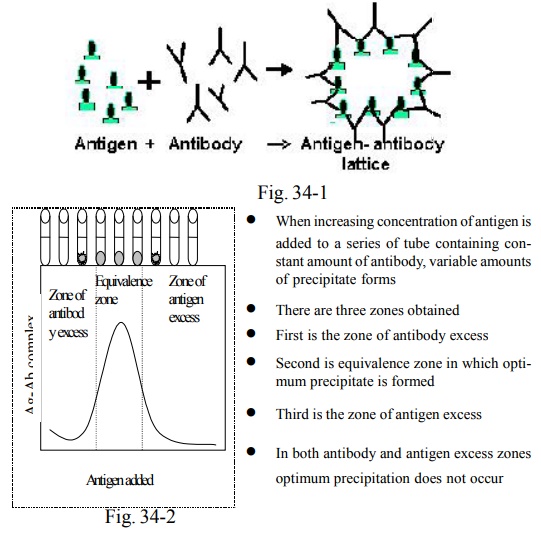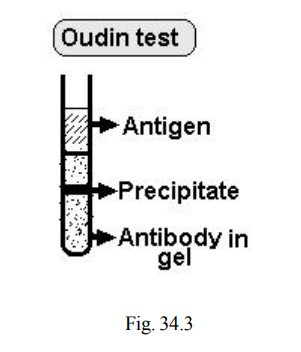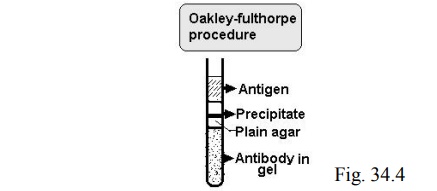Chapter: Microbiology
Precipitation Reactions: Test, Application
PRECIPITATION REACTIONS
Introduction
Precipitation Reaction
When a soluble antigen combines with its antibody in the pres- ence of electrolytes (NaCl) at a suitable temperature & pH the precipi-tation of antigen and antibody complex occurs. Precipitation occurs most rapidly and abundantly in which antigen and antibody are present in equivalent proportion. In the preceding tubes in which the antigen is excess & in the latter tube antibody is in excess the precipitation will be weak or even absent.
Quantitative Precipitation Test
Marrack (1934) proposed the lattice hypothesis to explain the mechanism of precipitation. According to this concept, multivalent an-tigen combines with bivalent antibody in varying proportions. Precipi-tation results when a layer of lattice is formed consisting of alternating .antigen and antibody molecules. This is possible only at zone of equiva-lence. In the zones of antigen and antibody, excess, the lattice does not exist.

Application of Precipitation Reaction
The precipitation test may be carried out either as quantitative or as a quantitative test. It is used for detecting antigen and antibody. It is therefore, used in application in the identification of blood and seminal stains and also in testing of food adulteration. The following types of precipitation tests are in common use:
I Ring Test
1. Ascoli test: This is used for the detection of bacterial antigen An-thrax in tissues /organs of dead animals or man.
2. It can be used for Lancefield grouping of Streptococci
II Slide test
In a clean slide a drop of antigen is taken and a drop of anti-body is mixed. Floccules appear. VDRL slide test for syphilis is done in this way
III Tube test
Antigen and antibody are allowed to react in the tubes to form precipitates. Khan test for syphilis is done in this way
IV Precipitation test in gels
Immunodiffusion is usually performed in a soft 1% agar gel. Antigen and antibody react in thin gel to form a line of precipitate
Types of Immunodiffusion
IV 1.Single diffusion in one dimension (Oudin Procedure)
Antibody is incorporated in agar gel in a test tube. The antigen solution is layered over it. The antigen diffuses downward through the agar gel forming a line of precipitation

Double diffusion in one dimension (Okley – Fulthorpe Procedue)
Antibody is incorporated in a gel in the tube. Above the anti-body a column of plain agar is placed. Antigen is placed on top of this. The antigen and antibody move towards each other in the column of plain agar and form the precipitation line

Single diffusion in two dimensions (Radial Immunodiffusion)
In this test the antibody is incorporated in the agar gel. Wells are cut in the gel. Antigen is added to the wells. The antigen diffuses radi-ally from the well and forms ring shaped bands of precipitation concen-trically around the well. The diameter of the halo gives the estimate of the concentration of the antigen
It is used to estimate the concentration of the classes of immuno-globulin in the serum

Double diffusion in two dimensions
Agar gel is poured on a slide and wells are cut. Antiserum is placed in the central well different antigens are placed in the surround-ing wells. Antigens and antibodies move towards each other and form precipitin lines. Different types of precipitin lines are formed. If the two adjacent antigens are identical, the lines of precipitate will fuse together. If they are not identical the lines will cross each other. If there is partial identity there will be a spur formation as seen in the figure

This test can be used for comparing different antigen and anti-body systems.
Other types of immuno precipitation tests in gel are immuno elec-trophoresis, electroimmunodiffusion and crossed immunoelectrophore-sis etc.
Related Topics